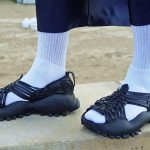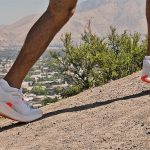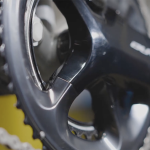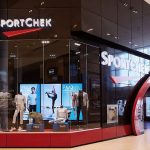Nike’s move to slash its sales forecast for the year ahead resulted in downgrades from UBS, Stifel, JPMorgan, and Morgan Stanley. Some analysts cited opportunities for Adidas, Lululemon, Hoka, On, and other competitors to gain shelf space as Nike’s overreliance on lifestyle offerings and innovation struggles continue. Other analysts lowered their firm’s price targets on NKE shares in reaction to the company’s weak year-end report and fiscal 2025 outlook reported last week.
As reported, Nike expects sales to decline mid-single-digits in its fiscal year ended May 31, 2025, including a high-single-digit decrease in the first half. On its fiscal third-quarter fall in mid-March, Nike had forecasted sales would increase for the year with a low-single-digit decline in the first half. Nike’s fourth-quarter earnings, released after the market closed on Thursday, June 27, topped estimates on improving margins, although sales were slightly below targets.
Nike attributed its downward FY25 revision to a further slowdown in its lifestyle products business, with steeper reductions now planned in the supply of its three largest lifestyle franchises: Air Force 1, Air Jordan 1 and Dunk. Nike also forecasted sluggish online growth, led by those franchises, and expects reduced growth in China for the next twelve months.
NKE shares declined 20 percent on Friday, June 28, on the New York Stock Exchange. The stock is now about 33 percent down from its $108.57 price at the start of 2024 and more than half off its all-time high of $177.51 reached on November 5, 2021.
Some analysts continue to recommend Nike’s stock, as the lower share price offers an attractive entry point for investors who are patient enough to wait for a delayed sales recovery. Many of those downgrading the stock following the revised guidance or in recent weeks are less certain about the timing of the sales growth inflection point. Some also see rising competitive pressures.
In a note Nike issued Friday morning, June 28, John Kernan, at TD Cowen, said that while Nike has a competitive advantage in basketball and areas of lifestyle/fashion, emerging competitors in footwear and apparel embracing other viewpoints and tastes are proving there are alternative paths to gain share.
“Nike has become overexposed to mid-tier, fashion-based trends that are being disrupted by more premium-based brands such as Hoka, On, Lululemon, and other upstarts that are appealing to consumers.,” wrote Kernan. “The concept of being all things to all consumers in the sector is effectively over, and Nike management needs to pivot.”
Cowen slashed its price target on Nike to $75.00 from $89.00. Kernan kept his “Hold” rating on Nike while indicating he favors Skechers and Deckers, the parent of Hoka and On.
Adidas, seen as Nike’s primary rival, received a few favorable notes from analysts ahead of its earnings report expected in July due to its improved momentum in the marketplace.
On Friday, June 28, RBC Capital Markets reiterated its “Outperform” rating on Adidas while raising its price target to €250.00 from €225 and earnings estimates. Analyst Piral Dadhania wrote that he expects Adidas to show a “solid” second-quarter performance. “Revenue growth should be supported by ongoing Terrace product momentum, sporting events and Yeezy, wrote Dadhania. Gross margins should remain strong with multi-lever support (ex FX). Management remains confident in accelerating 2H revenue trends, which could broaden in our view,” citing opportunities in cold-weather and running apparel.
Dadhania, who also covers Nike, said he favors Adidas in his sporting goods coverage because of Adidas’ “favorable brand/product momentum.“ The analyst has a “Sector Perform” rating on Nike.
Deutsche Bank, on Wednesday, June 27, likewise raised its price target on Adidas to €255.0 from €222 for similar reasons. Analyst Adam Cochrane wrote, “Adidas is on trend. We see the brand heat for its Terrace trend continuing and this is likely to be bolstered by football related apparel sales. The positive Terrace impact will be felt across most regions and in the gross margin.
The upbeat views on Adidas come as a global survey issued by Citi’s analyst Paul Lejuez, taken in early June 2024, ahead of Nike’s earnings, found Adidas gaining share across North America, China and Europe, although Nike remained in a “solid“ leadership position across all three regions. The findings were similar to those of a Citi survey taken in March 2024. The survey found Adidas gaining “significant ground“ in the Chinese market, ranking first in NPS (net promoter score), intent to purchase and most innovative athletic brand as perceived by the consumer. Nike was still seen in a “solid position in China with strong NPS/intent to purchase results.“
Li Ning, New Balance, Xtep, Under Armour, and Asics were among the other athletic brands that saw increased purchase intent in China.
In North America, Adidas remains a “distant second“ to Nike across metrics, although the brand showed some gains. In the March and June 2024 Citi surveys, Hoka, On, New Balance, and Converse increased in purchase intent. In the EMEA, Adidas remains a “close second with most other competitors trailing well behind Nike and Adidas.“ Brands showing increased intent to purchase in the EMEA included New Balance, Asics and Reebok.
Lejuez, who does not cover Adidas, kept his “Buy“ rating on Nike following the fourth-quarter report while lowering his target price to $102 from $115. The analyst wrote, “The big question is whether guidance is low enough. Although there are signs of life in the performance category (where early product wins in running/fitness/ basketball and stronger order books support an improving 2H sales outlook), topline visibility is low as NKE executes a complex turnaround in a tough macro, though seemingly conservative margin guidance may provide an opportunity for EPS upside.”
Following the sales warnings, JPMorgan’s rating on Nike’s stock was downgraded to “Neutral;“ Morgan Stanley’s was downgraded to “Equal Weight;” Stifel’s was downgraded to “Hold;” and UBS’s was downgraded to “Neutral.“
Jim Duffy, at Stifel, also cut his price target to $88 from $117. Duffy wrote, “The FY25 guide (the 5th downward consensus revision in 6 quarters) pushes prospects for growth inflection further into 2025 (perhaps FY4Q or spring ’25 at the earliest), asking investors to both underwrite the success of not yet proven styles and look across an uncertain consumer discretionary backdrop into 2HCY24 until momentum could build again into 2HCY25. Management credibility is severely challenged, and the potential for C-level regime change adds further uncertainty. An Investor Day in November will likely outline a multi-year economic model with lower returns than the precedent, adding risk to the premium enjoyed in the historical multiple. We remain appreciative of Nike’s scale advantage in a category with secular growth tailwinds and structural margin potential but, at the current valuation, can’t support a compelling upside case until growth inflection becomes more tangible.”
At UBS, Jay Sole slashed his price target to $78 from $125, seeing challenges and “no quick turnaround.“ He believes Nike needs to balance performance and lifestyle assortments better. Sole wrote, “Nike will probably lose market share as it resets its business over the next few years. We believe Nike leaned into its lifestyle/fashion business too much and now it needs to rebalance its assortment back into more athletic performance products. This will likely take a few years to occur, and means Nike may lose share in the lifestyle component of its business.“
Williams Trading, which reduced its rating on Nike to “Sell“ on May 18, kept its rating and reduced its price target from $75 to $67.
Analyst Sam Poser wrote, “The major problem is that the FY25 guidance likely does not represent the worst-case scenario. Within the prepared remarks on the 4Q24 earnings call, the CFO stated that Nike had previously had a successful reset in 2018 after a few years of disappointing results. The Nike talent today does not, in our view, hold a candle to the talent at Nike 7 years ago. Further, after laying off over 17 percent of the workforce, including many very talented individuals, and the exit of other talented people on their own accord, management double-dribbled by stating it would invest some $1B on new talent and by complementing the culture, which has been annihilated, over the past 4 years, based on our checks.”
Oppenheimer wrote on Friday morning, June 28, among the more optimistic analyst notes, that it reiterated its “Outperform“ rating and maintained its $120 target. Brian Nagel noted that Oppenheimer, on June 21, upgraded Nike due to its historically depressed share valuation, downbeat investor sentiment and intermediate to longer-term fundamental recovery prospects, and those conditions largely remain.
“While Q4 (May) results and updated FY25 (May) guidance proved even weaker than our downbeat and below Street forecasts, we still look upon last night’s announcement and commentary as likely a “‘last bad‘ quarter and ‘healthy clearing event‘ for NKE,“ said Nagel. “NKE is working to aggressively reposition the company’s global enterprise amid an increasingly soft demand backdrop in the US and in markets across the globe. We continue to very much expect NKE efforts to help to fuel an even stronger recovery at the company, as cyclical pressures ease.”
Evercore ISI kept its “Outperform“ rating while trimming its price target to $105 from $110. Analyst Michael Binetti wrote, “While we’re disappointed, we think Nike gravitating to our low-end scenario builds in a lot of the right things to get a believable turnaround off the ground (albeit with some lingering risk related to a 2H revenue acceleration). That said, we think the chance to own a bona fide Nike turn at [about] 1 [standard deviation] below the 10-year average P/E is very attractive, but investors will have to be patient with the turnaround story.”
Wedbush maintained its “Outperform“ rating while reducing its price target to $97 from $115. Analyst Tom Nikic wrote, “We doubt many investors will view this as a ‘buy the pullback’ event, and we think NKE shares are headed for a stay in the proverbial penalty box until new product innovations actually start to manifest themselves and management regains investor trust. We remain at Outperform due to our expectation that NKE will eventually ‘figure it out‘, but our conviction in our thesis has certainly taken a hit.”
Telsey Advisory Group analyst Cristina Fernández kept her “Outperform“ rating on Nike while trimming her price target to $110 from $115, reflecting the likelihood of a brand turnaround will get pushed out to FY26 from 2HF25. Fernández wrote, “Overall, we view the lowered guidance as primarily self-inflected due to a lack of newness and proactive actions to reduce supply, rather than a broader slowdown in the athletic footwear industry, as brands like Adidas, Puma and New Balance are growing in lifestyle. Nonetheless, we see reasons to stay positive on the stock and Nike’s turnaround. First, product introductions are increasing over the next few years, with positive initial responses to launches like Pegasus 41. Two, partners like Dick’s Sporting Goods and Foot Locker have expressed excitement around Nike’s product pipeline with order books in running up DD for Spring 2025 led by Pegasus 41. Three, Nike is seeing strength in performance, which was up DD in 4QF24, led by basketball and football.“
Image courtesy Nike
















